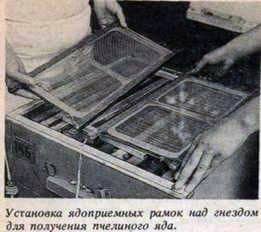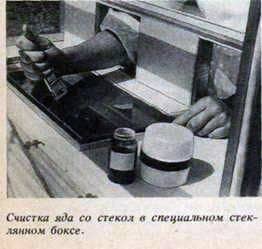
As is known, neither scientists nor practitioners have yet come to a common opinion about acceptable methods of poison selection, that is, the optimal location of the sampling devices in the hives, the frequency of poison selection during the season. The influence of the duration of the poison selection season on the status of families, honey production, brood rearing, on the results of wintering has not been studied. In this regard, for the development of technology suitable for mass procurement of bee venom, a series of experiments on families equivalent to the number of bees, brood, fodder stocks, age and breed of queens have been carried out at the apiary of the Institute of Apiculture.
To stimulate the bees by an electric current, the impulse “Pchelka” and “Biz-3” were used by the original impulse generator, made by AI Toroptsev, the Institute’s employee, as well as the impulse devices developed on its basis by the Central Scientific Research Institute of Complex Automation.
In 1988, poison was selected from July 9 to August 6 in five groups. The first group was a control group, no poison was taken; the second – poison was taken inside the nest three times in ten days; in the third, poison was taken from the nest three times also in ten days. In the fourth group, poison was collected over the nest six times in five days, in the fifth, poison was taken ten times over the nest three days later. Each of them included eight families of bees of the Priokskaya breed group. The mode and the duration of the electric shock for all groups are the same.
In 1989, the selection period for poison was increased to two months. Work was carried out on families in packages. A group of families entered the control, from which poison was taken from the nest three times in ten days with a three-hour electrical stimulation.
In the second group, poison was taken over the nest six times in ten days, with a two-hour electrostimulation for an hour with a break of 30 minutes.
In the third group, the poison was taken simultaneously inside the nest and over the nest six times in ten days, the time of electrostimulation was three hours.
For one selection, three-time electrostimulation of bees inside the nest on the average received 296 mg of poison from one family, or 53.4-64.2% more than the selection of poison over the nest.
However, the selection of poison in the nest is very laborious and inconvenient, since with this method it is necessary to prepare in advance wells for the jadopriemnyh frames – remove from the hives for two or three honeycombs, often with brood.
Families, from which poison was selected, grew 13.6-24.1% less than brood in this period. Selection of poison in the nest reduced the honey production of bees by 4.2 kg (19.6%). To a lesser extent, the selection of poison over the nest had a negative effect on honey gathering – this indicator decreased by only 0.7-2.2 kg (by 2.8-10.2%). Of particular interest is the three-time, ten-day selection of the poison over the nest, in which the honey is almost the same as in the control – without selecting the poison.
An increase in the frequency of poison selection from three to ten within a month reduces the number of families served during this time. As a result, the gross yield of poison decreases by 29-42%, with the increase in labor costs per unit of output and a decrease of 29.7-44.4% in economic efficiency. This is due to a decrease in the amount of poison produced at each subsequent stimulation of bees in families.
The poison obtained during selection in the nest and above the nest has a high biological activity and in all indices meets the requirements of TU. Therefore, the methods of obtaining the poison we tested are suitable for practical use.
In 1989, three meals a day for a season with a three-hour electrostimulation received from each family an average of 607 mg of poison, or 202.3 mg per electrical stimulation. With the same method of poison selection, by reducing the electrostimulation to two hours (for an hour with a break of 30 minutes), an average of 27 mg (13.4%) of poison was obtained for a single selection in comparison with a three-hour stimulation of bees by an electric current.

With the simultaneous selection of venom in the nest and over the nest, for three such operations, an average of 840 mg of poison was obtained from one family, or 280 mg at a time, that is, 38% more compared to the control.
The increase in the time taken for the selection of the poison to two months (six withdrawals every ten days) made it possible to receive additionally from each family when the sampling device was positioned above the nest by 489 mg (67.2%) and at the same time taking in the nest and over the nest – 633 mg (by 142.7%), poison is more in comparison with the control, that is three times.
Although more venom was collected during the simultaneous selection of the poison in the nest and over the nest, these families raised less brood than the control ones by 25.5%, and by 15% compared to families from which the poison was not taken.
Families, from which poison was selected six times per season with a two-hour stimulation with electric current, grew 15.2% more than the brood compared to the control and 31.4% more than the families from which the poison was not taken.
With a six-season selection of poison over the nest, the honey production of bees increased by 19.5% compared to the control three-time selection.
When selecting poison simultaneously in the nest and above the nest, we received 56% less honey compared to the control. These data confirm the results of previous studies, when the selection of the poison in the nest led to a decrease in the medo-productivity of families by 10-27%.
Families that did not take poison were harvested at 24.5 and 36.9% less honey compared to families in which poison was taken from the nest three or six times.
With a six-time selection of poison per season, compared to three times the working time per unit of output increases by 20.5% while a decrease in the production of poison by 11.9%.
Simultaneous selection of the poison in the nest and above the nest led to a decrease of 58% in the honey production of families and greatly weakened them.
Thus, the most acceptable reception of poison over the nest or in the nest of bees, with a three-time stimulation of the family by electric current in ten days for two or three hours each time.
At the same time in the nest two detecting frames with a total area of 1600 cm2 of glass panes are used. As a result, from one family, an average of 600-800 mg of poison can be obtained.
According to the 1989 studies, the selection of poison does not adversely affect the hibernation of bees.
Now work is continuing to clarify the technology for obtaining poison, with the exception of further negative impact on development, honey production and wintering of families.
Виды и порода пчел. Как закалить электрод.
Bee venom